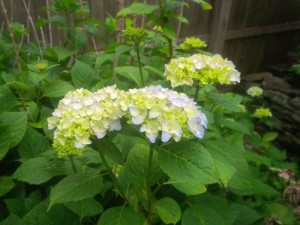 Sometimes you choose to make changes in the landscape. Sometimes the landscape does the deciding. In my case, the situation is a little bit of both. The wooden perimeter fence that bounds my backyard is decrepit and needs replacing. It was handsome once, but that was fifteen years ago. Weather and normal aging have done their work and now the fence is missing slats in some places and wobbles alarmingly in others. The wooden gate that connects the front and back yards has lost its latch, making it easy for that alpha male deer, Mr. Antlers, and his brood to stroll right through.
Sometimes you choose to make changes in the landscape. Sometimes the landscape does the deciding. In my case, the situation is a little bit of both. The wooden perimeter fence that bounds my backyard is decrepit and needs replacing. It was handsome once, but that was fifteen years ago. Weather and normal aging have done their work and now the fence is missing slats in some places and wobbles alarmingly in others. The wooden gate that connects the front and back yards has lost its latch, making it easy for that alpha male deer, Mr. Antlers, and his brood to stroll right through.
In this post-pandemic era, when every other driveway in my neighborhood contains a dumpster that bears silent witness to an ongoing renovation project, it was hard to find an available fencing contractor. I accomplished that after several weeks of frequent phone calls. Now, the eye-watering estimate has been accepted, the work is scheduled for about two weeks from now and the neighbors have been alerted. The hardest part—aside from giving the contractor all my money—will be clearing the extraneous vegetation from the area in front of the fence. When I say “extraneous”, I mean “excessive”.
Like many people, I have planted shrubs in front of much of the fencing, and all of them are vigorous to say the least. The three blue, mophead hydrangeas have thrived, especially after the cool, relatively wet spring. Their relative, the oakleaf hydrangea, which began life as a root sucker of the gargantuan bush in the front garden, now threatens to dwarf its parent. A butterfly bush, which I love for its midnight purple blooms, reaches in all directions, including right over the fence. Two roses of Sharon have also grown to impressive size.
All of those leafy specimens are now undergoing a process that corporate types call “right sizing”. The end result will be more manageable shrubs, backed by a corridor that will be easily navigable for the fence installers.
In addition to dealing with the welcome inhabitants of the garden, I also have to discipline the rampant English ivy that I have peeled back from the fence on a regular basis for years. The ivy is positively well-mannered compared to my neighbors’ wisteria, which is expansion-minded, invasive and extremely opportunistic. It was planted at least two generations ago and has spread its thick vines under and above ground wherever it can find even a square millimeter of soil. It has surged beneath the fence and over the top. Now it has to go.
All of the above is easy to do as long as you have the right tools and a high tolerance for being sweaty, achy, itchy, overheated, dehydrated, dirty and festooned with cobwebs. Since I am doing the job incrementally, I experience all of those things about every other day.
As with many other tortuous processes, this clearing exercise is not without its benefits. I have finished with the mophead hydrangeas and the butterfly bush and I must admit that they look better than they have in years. Newly trimmed and tidied, they can take their rightful places as purposeful parts of the design, rather than random additions. The trunk of the butterfly bush split during a storm several years ago, but at the time I couldn’t bear to do the radical pruning necessary to reinvigorate it. Now the weaker half is gone, and the newly renovated butterfly bush looks healthier already. I am sure the same will be true of the oakleaf hydrangea and the roses of Sharon.
This is certainly not the optimal time to trim all of the shrubs, and I may lose a few of next year’s blooms for my efforts. I think the improvement in plant health and appearance will compensate for that, as will the new fence.
Gardens are about using both positive and negative spaces. By creating more negative space around my shrubs, I have added depth and definition to my planting scheme. There is already something Zen about the look of the shrub border. I didn’t know how much I needed that until it happened.
As for the ivy and the wisteria, I will have made small a dent in their mutual quest for landscape hegemony. Maybe the effort will even inspire me to pursue the English ivy eradication project that I should have done years ago.
The new fence and all the pre-installation editing will also make the whole garden look more beautiful and I intend to spend a lot of time enjoying that this fall. Since I will have no money, I am sure it will be a great comfort.
